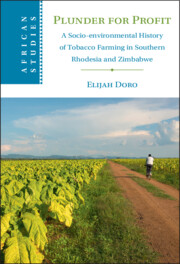121 results
8 - Legal but Harmful: Prescription Medications, Tobacco, Vaping and Alcohol
-
- Book:
- How to Talk to Your Child About Drugs
- Published online:
- 13 February 2025
- Print publication:
- 06 March 2025, pp 162-181
-
- Chapter
- Export citation
Population-based assessment of major congenital malformations in the United States: smoking risk association
-
- Journal:
- Journal of Developmental Origins of Health and Disease / Volume 16 / 2025
- Published online by Cambridge University Press:
- 27 February 2025, e13
-
- Article
- Export citation
Chapter 13 - Early American Plant Writing
- from Part III - Global Regions
-
-
- Book:
- The Cambridge Handbook of Literature and Plants
- Published online:
- 06 February 2025
- Print publication:
- 13 February 2025, pp 251-267
-
- Chapter
- Export citation
11 - Two Cartels in the Supply Chain
-
-
- Book:
- Cartels Diagnosed
- Published online:
- 06 December 2024
- Print publication:
- 02 January 2025, pp 317-341
-
- Chapter
- Export citation
Associations of cannabis use, tobacco use, and incident anxiety, mood, and psychotic disorders: a systematic review and meta-analysis
-
- Journal:
- Psychological Medicine / Volume 54 / Issue 15 / November 2024
- Published online by Cambridge University Press:
- 02 December 2024, pp. 4287-4301
-
- Article
-
- You have access
- Open access
- HTML
- Export citation
Chapter 20 - Fatwās on Aspects of Modern Life
- from Part III - Legal Opinions (Fatwās)
-
-
- Book:
- Islamic Law in Context
- Published online:
- 14 November 2024
- Print publication:
- 21 November 2024, pp 214-222
-
- Chapter
- Export citation
Why hospitals hire tobacco lobbyists: conflicts of interest among lobbyists’ clients
-
- Journal:
- Journal of Public Policy / Volume 44 / Issue 4 / December 2024
- Published online by Cambridge University Press:
- 14 October 2024, pp. 697-719
-
- Article
-
- You have access
- Open access
- HTML
- Export citation
Determinants of substance use among young people attending primary health centers in India
-
- Journal:
- Cambridge Prisms: Global Mental Health / Volume 11 / 2024
- Published online by Cambridge University Press:
- 12 February 2024, e23
-
- Article
-
- You have access
- Open access
- HTML
- Export citation
8 - Improving Population Health
- from Part 1 - The Public Health Toolkit
-
-
- Book:
- Essential Public Health
- Published online:
- 01 December 2023
- Print publication:
- 14 December 2023, pp 145-162
-
- Chapter
- Export citation
2 - Shifting Mass Tort Theories in the 1990s and the Judicial Resistance to the Expansion of Public Nuisance Liability
-
- Book:
- Public Nuisance
- Published online:
- 02 November 2023
- Print publication:
- 16 November 2023, pp 26-47
-
- Chapter
- Export citation
Chapter 29 - Tobacco Use among Individuals with Cannabis Use
- from Part VIII - Special Topics
-
-
- Book:
- Marijuana and Madness
- Published online:
- 12 May 2023
- Print publication:
- 01 June 2023, pp 310-320
-
- Chapter
- Export citation
A systematic review of digital interventions for smoking cessation in patients with serious mental illness
-
- Journal:
- Psychological Medicine / Volume 53 / Issue 11 / August 2023
- Published online by Cambridge University Press:
- 10 May 2023, pp. 4856-4868
-
- Article
-
- You have access
- Open access
- HTML
- Export citation
Tobacco use in first-episode psychosis, a multinational EU-GEI study
-
- Journal:
- Psychological Medicine / Volume 53 / Issue 15 / November 2023
- Published online by Cambridge University Press:
- 26 April 2023, pp. 7265-7276
-
- Article
- Export citation
Introduction
-
- Book:
- Plunder for Profit
- Published online:
- 06 April 2023
- Print publication:
- 13 April 2023, pp 1-33
-
- Chapter
- Export citation
5 - ‘The Threat of Soil Erosion Is Far More Permanent Than the Threat of Sanctions’
-
- Book:
- Plunder for Profit
- Published online:
- 06 April 2023
- Print publication:
- 13 April 2023, pp 198-224
-
- Chapter
- Export citation
3 - A Silenced Spring? Exploring Africa’s ‘Rachel Carson Moment’
-
- Book:
- Plunder for Profit
- Published online:
- 06 April 2023
- Print publication:
- 13 April 2023, pp 123-164
-
- Chapter
- Export citation

Plunder for Profit
- A Socio-environmental History of Tobacco Farming in Southern Rhodesia and Zimbabwe
-
- Published online:
- 06 April 2023
- Print publication:
- 13 April 2023
Lifetime caffeine and adolescent nicotine exposure in mice: effects on anxiety-like behavior and reward
-
- Journal:
- Journal of Developmental Origins of Health and Disease / Volume 14 / Issue 3 / June 2023
- Published online by Cambridge University Press:
- 03 April 2023, pp. 362-370
-
- Article
- Export citation
Substance use and psychotic-like experiences in young people: a systematic review and meta-analysis
-
- Journal:
- Psychological Medicine / Volume 53 / Issue 2 / January 2023
- Published online by Cambridge University Press:
- 15 November 2022, pp. 305-319
-
- Article
-
- You have access
- Open access
- HTML
- Export citation
Educational Attainment Polygenic Scores: Examining Evidence for Gene–Environment Interplay with Adolescent Alcohol, Tobacco and Cannabis Use
-
- Journal:
- Twin Research and Human Genetics / Volume 25 / Issue 4-5 / October 2022
- Published online by Cambridge University Press:
- 03 October 2022, pp. 187-195
-
- Article
-
- You have access
- HTML
- Export citation

